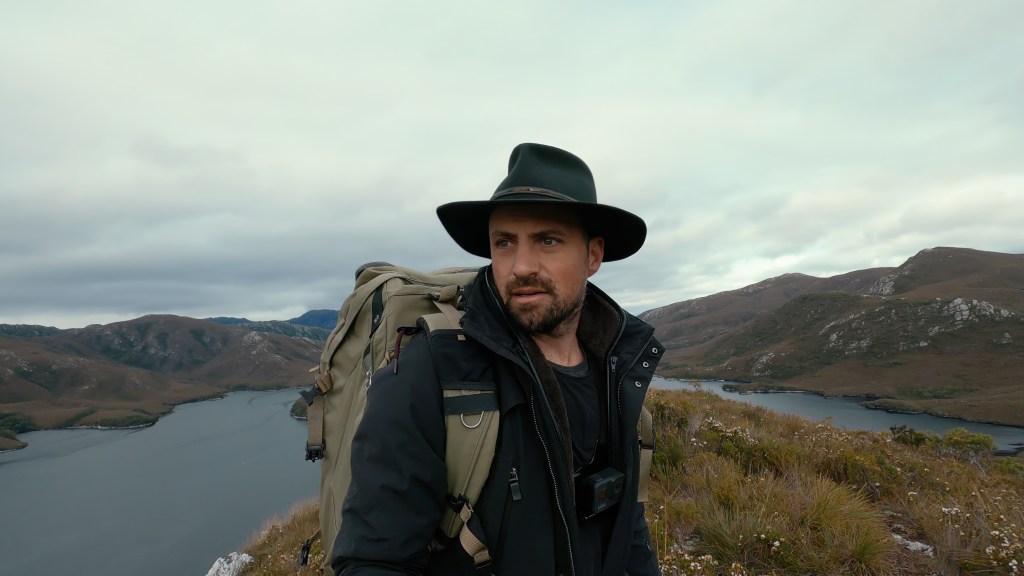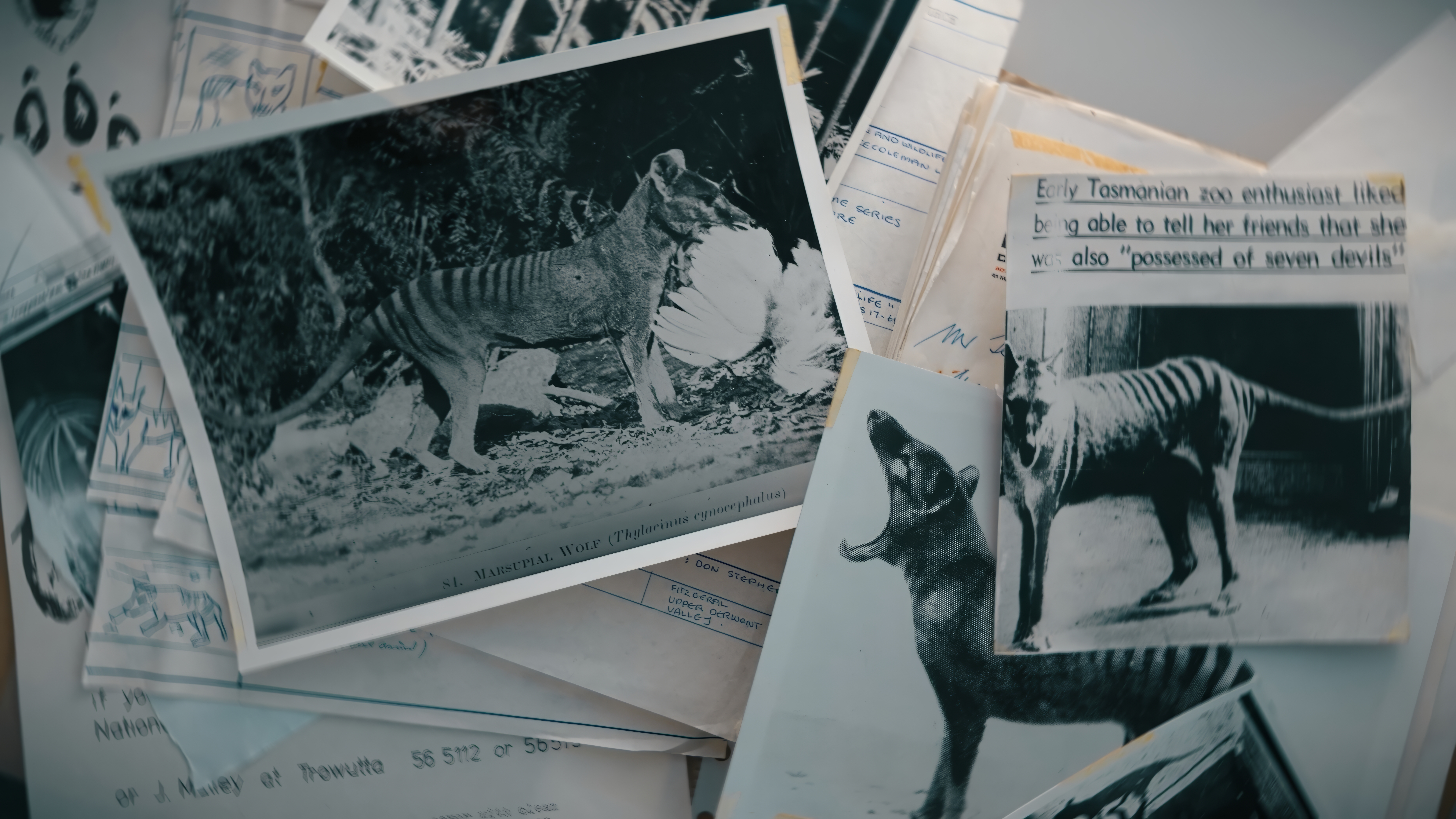Tim Noonan has made documentary series in some of the most wild and remote regions on earth – from the Amazon to Africa – yet his most extreme adventure was lurking right near his home in Tasmania.
“It’s total frontier wilderness – harsh, unforgiving, and really difficult to break your way into these areas,” he says of the remote South West region. “It’s only when you’re standing there that you realise this is a lost world and it could be the last stronghold for a species to go surviving undetected.”
That species is the Thylacine – or the Tasmanian tiger – which was thought to have gone extinct in 1936. Noonan spent a year chasing the story, captured in his new two-part SBS series Hunt for Truth: Tasmanian Tiger.
But unlike many archival-based Tiger stories, Noonan’s series tracks a live search, including stints embedded with the University of Tasmania (which installed more than 2,000 motion detecting cameras around the island in an attempt to capture Tiger footage), and to Papua New Guinea, where eyewitness reports suggest the tiger may exist there.
The tragedy of the Tasmanian tiger, which continues to be seen by eyewitnesses, maintains an enduring hold over the Australian psyche.
“We treat our wildlife like assets to exploit and historically – that’s how the Thylacine has been regarded,” Noonan says. “I think that’s why it strikes a chord with the public – we did it so recently, we killed it off, and hunted it so brutally, that it’s always a shocking reminder of what we can do. It’s such an iconic animal, it would have the power if it was rediscovered to change the face of conservation globally because we would go, ‘What a magnificent survival story’.”
The series includes first-hand accounts from witnesses – some colourful but all deemed credible by the University – who have never spoken publicly.
“They took a lot of convincing to go on camera and tell their stories,” Noonan says. “I was constantly assessing their motivations about why they were agreeing to be on camera in the first place because getting to the truth is paramount for this show. Every single person could have taken it or left it, but they knew what they thought they saw and they totally believed it.”
Noonan is certain the Tiger survived far longer than the official 1936 extinction date. A recent University of Tasmania study of 1,237 witness records suggests the Tiger may have held on until the late 1980s to early 2000s, with a very small chance that it still lives in remote south-western wilderness areas.

“They’re either cases of mistaken identity or they really did see the animal,” Noonan says of the many witness testimonies. “This is the heartbreaking thing – if they did see it out there, are we sitting idle and letting this animal go extinct for what could be a third time? We almost certainly let it go extinct twice because we didn’t get out there and search properly for it. We declared it extinct prematurely.”
The hunt for the Tiger took Noonan to Papua New Guinea where eyewitness reports of a “stripey dog” suggest it may have survived from the last ice age some 30,000 years ago when the two land masses first joined.
It would not be the first time an “extinct” species has been rediscovered in disparate locations. The giant coelacanth fish was thought to have become extinct around 65 million years ago but was rediscovered in 1938 off the east coast of South Africa. A similar species was discovered more than 10,000 kilometres away in Indonesian waters in the late-1990s.
But the trip to Papua New Guinea was not without dangers.

“Just last year, there was an Australian archaeologist who was kidnapped and held for ransom and there was an Australian pilot that was kidnapped when I was there. So the risks were real and it was dangerous. My wife got kidnap insurance, which was just extremely expensive. But something magical always happens there and the danger is all part of it.”
Noonan has become a master at solo shooting in extreme conditions – his previous documentary series include Boy to Man and Extreme Engagement – and as director of photography for SBS’ Alone series he shoots the high-end visuals and teaches contestants how to film themselves. He has also won two Walkley Awards for cinematography and offers film-making classes to other solo creators.
He says he now relies on a range of Canon cameras “which are pretty bulletproof” to survive the extreme conditions he encounters, and his style has become more rugged to convey authenticity.
“I’ve realised over the years that if you make everything look too good, sometimes people don’t believe it. Filming by yourself and filming yourself at the same time is also really challenging, so now I come equipped with GoPros sticking all over myself and GoPros on sticks that I set up at any given point.

“I’ve embraced in this series showing the behind-the-scenes as much as what I’m shooting, so that I only have to do something once and you’re getting all of the natural reactions because I’ve got five cameras rolling on any given situation, so that the audience knows that this is real, and it’s not constructed.”
It is an issue that will become increasingly fraught as the adoption of cheap artificial intelligence software begins to cast doubt on all footage.
For now, the investigation continues. Each episode of Hunt for Truth: Tasmanian Tiger features a call to action so producers can crowdsource new information and generate new leads.
“We’re now going to be inviting the public to help in the participation of the next installment and uncover the truth. If the Tasmanian tiger is still out there, let’s hope enough people come forward so we can either put this mystery to bed or make some incredible discovery that’ll change the world.”
Hunt for Truth: Tasmanian Tiger is available to watch on SBS On Demand from July 12.


